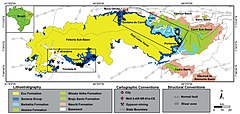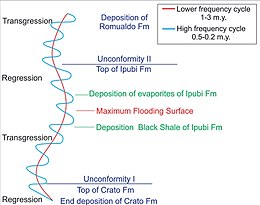Crato Formation
| Crato Formation | |
|---|---|
| Stratigraphic range: Latest Aptian ~ | |
| Type | Geological formation |
| Unit of | Santana Group |
| Sub-units | Nova Olinda Member |
| Underlies | Romualdo & Ipubi Formations |
| Overlies | Barbalha Formation |
| Lithology | |
| Primary | Mudstone, limestone |
| Other | Siltstone |
| Location | |
| Coordinates | 7°06′S 39°42′W / 7.1°S 39.7°W |
| Approximate paleocoordinates | 8°36′S 8°00′W / 8.6°S 8.0°W |
| Region | |
| Country | |
| Extent | Araripe Basin |
| Type section | |
| Named for | Crato, Ceará |
 Extent of the Santana Group, to which the Crato Formation belongs, in blue | |
The Crato Formation is a geologic formation of Early Cretaceous (Aptian) age in northeastern Brazil's Araripe Basin. It is an important Lagerstätte (undisturbed fossil accumulation) for palaeontologists. The strata were laid down mostly during the Aptian age, about 113 million years ago. It thought to have been deposited in a semi-arid lacustrine wetland environment.[1]
The Crato Formation earns the designation of Lagerstätte due to an exceedingly well preserved and diverse fossil faunal assemblage. Some 25 species of fossil fishes are often found with stomach contents preserved, enabling paleontologists to study predator-prey relationships in this ecosystem. There are also fine examples of pterosaurs, reptiles and amphibians, invertebrates (particularly insects), and plants. Even dinosaurs are represented: a new maniraptor was described in 1996. The unusual taphonomy of the site resulted in limestone accretions that formed nodules around dead organisms, preserving even soft parts of their anatomy.
History

Fish fossils in the area were noted in 1823. When they were first methodically published, in 1993, the Crato Formation limestones provided a new site for pterosaurs, one that also preserved insects that fell into a brackish lagoon and semionotid fish preserved in phosphatized nodules. The fossils are usually compacted and preserved in layers of limestone. Fossil Odonata (dragonflies) and damselflies are especially rich in the Crato lagerstätte: currently 384 specimens have been recovered, 264 adults and 120 larvae. Hemiptera (true bugs) and Orthoptera (grasshoppers and crickets) are also abundant in number of species and in number of specimens. There are also plant remains.
Local mining activities for cement and construction damage the sites. Trade in illegally collected fossils has sprung up in the last decade, driven by the remarkable state of preservation and beauty of these fossils and amounting to a considerable local industry. An urgent preservation program is being called for by paleontologists.
In addition, the weathering of Crato and Santana Formation rocks has contributed soil conditions unlike elsewhere in the region. The Araripe manakin (Antilophia bokermanni) is a very rare bird that was discovered only in the late 20th century; it is not known from anywhere outside the characteristic forest that grows on the Chapada do Araripe soils formed ultimately from Crato and Santana Formation rocks.
Definition

The Crato Formation has often historically been considered the lowest member of the Santana Formation (or, alternatively, the Araripina Formation) of the Araripe Group,[2] later redefined as the Romualdo Formation of the Santana Group.[3][4] The Crato Member is the product of a single phase, where complicated sequence of sediment strata reflect changeable conditions in the opening sea. The age of this strata has been controversial, though most workers have agreed that it lies on or near the Aptian-Albian boundary, about 112 million years ago.[5]
The extent of the Crato unit and its relationship to the Romualdo Formation had long been ill-defined. It was not until a 2007 volume on the unit by Martill, Bechly and Loveridge that the Crato Formation was given a formal type locality, and was formally made a distinct formation separate from the Santana, which is about 10 Ma younger.[5] The Crato Formation is considered time equivalent with the Paracuru Formation.[6]
Fossil content
Insects
(Note: Many more insects have been described than are present in the table below)
| Insects of the Crato Formation | ||||
|---|---|---|---|---|
| Genus | Species | Presence | Description | Images |
|
A. seldoni |
Nova Olinda Member |
A Nymphid lacewing |
||
|
G. pulchra |
An Eolepidopterigidae moth |
|||
|
M. adamsi |
A Kalligrammatid lacewing |
|||
|
M. longimanus |
A Coxoplectopteran insect |
 | ||
|
N. nana |
An Eolepidopterigidae moth |
|||
|
P. incerta |
An Ithonidae lacewing, type species of Principiala |
|||
|
P. calipsa |
An Eolepidopterigidae moth |
|||
|
R. maxima |
||||
|
U. cariensis |
An Eolepidopterigidae moth |
|||
Arachnids
| Arachnids of the Crato Formation | ||||
|---|---|---|---|---|
| Genus | Species | Presence | Description | Images |
| Protoischnurus | P. axelrodorum | Scorpion | ||
| Cratosolpuga | C. wunderlichi | Solifuge | ||
Fish
| Fish of the Crato Formation | |||||
|---|---|---|---|---|---|
| Genus | Species | Presence | Description | Images | Notes |
| Araripelepidotes | Araripelepidotes temnurus | ||||
| Belonostomus | Belonostomus sp. | ||||
| Calamopleurus | Calamopleurus cylindricus | ||||
| Cladocyclus | Cladocyclus gardneri | An Ichthyodectidae fish | |||
| Cratoamia | Cratoamia gondwanica | ||||
| Dastilbe | Dastilbe crandalli |  |
|||
| Lepidotes | Lepidotes wenzae | ||||
| Placidichthys | Placidichthys bidorsalis | ||||
| Santanichthys | Santanichthys diasii | ||||
Amphibians
| Amphibians of the Crato Formation | ||||
|---|---|---|---|---|
| Genus | Species | Presence | Description | Images |
|
Arariphrynus placidoi[19] |
||||
|
Cratia gracilis[19] |
||||
|
Eurycephalella alcinae[19] |
||||
|
Possible indeterminate pipoid remains.[19] |
||||
Squamata
| Squamatans of the Crato Formation | ||||
|---|---|---|---|---|
| Genus | Species | Presence | Description | Images |
|
C. alamoi |
A non-iguana lizard |
|||
|
T. amplectus |
A stem group snake with limbs |
 | ||
Dinosaurs
| Dinosaurs of the Crato Formation | ||||
|---|---|---|---|---|
| Genus | Species | Presence | Notes | Images |
|
?Avialan species |
Numerous isolated feathers |
 | ||
|
C. cearensis |
||||
|
K. mater |
||||
|
?Spinosaur species |
Isolated tooth |
|||
|
U. jubatus |
 | |||
Crocodylomorphs
| Crocodylomorphs of the Crato Formation | ||||
|---|---|---|---|---|
| Genus | Species | Presence | Description | Images |
|
Susisuchus anatoceps[21] |
 | |||
|
cf. Susisuchus sp.[22] |
Undescribed species | |||
Pterosaurs
| Pterosaurs of the Crato Formation | ||||
|---|---|---|---|---|
| Genus | Species | Presence | Description | Images |
|
A. conandoylei |
||||
|
A. cearensis |
A basal member of the Tapejarinae. |  | ||
|
B. sp. |
||||
|
L. magnificens |
Nova Olinda Member |
 | ||
|
L. sibbicki |
An anhanguerid |
 | ||
|
T. imperator |
 | |||
|
?T. sp. |
 | |||
Flora
Other fossils
- Araripenaeus timidus[24]
- †Cratoalloneura
- †Cratoatractocerus
- †Cratoborellia
- †Cratochrysa
- †Cratocora
- †Cratocordulia
- †Cratocoris
- †Cratocorydalopsis
- †Cratocossus
- †Cratodactylus
- †Cratoelcana
- †Cratoenigma
- †Cratogomphus
- †Cratogryllus
- †Cratohagenius
- †Cratohaglopsis
- †Cratohexagenites
- †Cratokalotermes
- †Cratolindenia
- †Cratolocustopsis
- †Cratolocustopsis araripensis
- †Cratolocustopsis contumax’ – type locality for species
- †Cratolocustopsis cretacea
- †Cratomacer
- †Cratomastotermes
- †Cratomyia
- †Cratonemonyx
- †Cratonemopteryx
- †Cratonepa
- †Cratonerthra
- †Cratoneura
- †Cratonympha
- †Cratopelocoris
- †Cratopetalia
- †Cratopetalura
- †Cratopsychopsis
- †Cratopteryx
- †Cratoraricrus
- †Cratoscalapha
- †Cratosirex
- †Cratosisyrops
- †Cratosmylus
- †Cratostenophlebia
- †Cratotabanus
- †Cratotetraspinus
- †Cratotipula
- †Cratovitisma
- †Cratovoluptia
- †Cratozeunerella
See also
References
- ^ Ribeiro, Alexandre Cunha; Ribeiro, Guilherme Cunha; Varejão, Filipe Giovanini; Battirola, Leandro Dênis; Pessoa, Edlley Max; Simões, Marcello Guimarães; Warren, Lucas Veríssimo; Riccomini, Claudio; Poyato-Ariza, Francisco José (May 2021). "Towards an actualistic view of the Crato Konservat-Lagerstätte paleoenvironment: A new hypothesis as an Early Cretaceous (Aptian) equatorial and semi-arid wetland". Earth-Science Reviews. 216: 103573. doi:10.1016/j.earscirev.2021.103573.
- ^ Scherer et al., 2013, p.28
- ^ Assine, 1992, p.291
- ^ Fabin et al., 2018, p.2050
- ^ a b Martill et al., 2007
- ^ Leite da Silva, 2003
- ^ Myskowiak, 2016
- ^ Bechly et al., 2016
- ^ Makarkin & Menon, 2007
- ^ Aparecida et al., 2015, p.25
- ^ Aparecida et al., 2015, p.35
- ^ Aparecida et al., 2015, p.29
- ^ Aparecida et al., 2015, p.36
- ^ Aparecida et al., 2015, p.31
- ^ Aparecida et al., 2015, p.51
- ^ Aparecida et al., 2015, p.26
- ^ Aparecida et al., 2015, p.33
- ^ Aparecida et al., 2015, p.47
- ^ a b c d e f g h Báez et al., 2009
- ^ de Souza Carvalho, I.; Agnolin, F. L.; Rozadilla, S.; Novas, F. E.; Ferreira Gomes Andrade, J. A.; Xavier-Neto, J. (2021). "A new ornithuromorph bird from the Lower Cretaceous of South America". Journal of Vertebrate Paleontology. 41 (4): e1988623. doi:10.1080/02724634.2021.1988623. S2CID 244059488.
- ^ Salisbury et al., 2003
- ^ Figueiredo & Kellner, 2009
- ^ Jorge de Lima et al., 2015, p.102
- ^ Pinheiro, 2014, p.4
Bibliography
- Template:Cite LSA
- Template:Cite LSA
- Template:Cite LSA
- Template:Cite LSA
- Template:Cite LSA
- Template:Cite LSA
- Template:Cite LSA
- Template:Cite LSA
- Template:Cite LSA
- Template:Cite LSA ISBN 978-1-139-46776-6
- Template:Cite LSA
- Template:Cite LSA
- Template:Cite LSA
- Template:Cite LSA ISBN 0-520-24209-2
Further reading
- Crato Formation
- Geologic formations of Brazil
- Lower Cretaceous Series of South America
- Cretaceous Brazil
- Mudstone formations
- Limestone formations
- Deltaic deposits
- Lacustrine deposits
- Paleontology in Brazil
- Environment of Ceará
- Environment of Pernambuco
- Environment of Piauí
- Landforms of Ceará
- Landforms of Pernambuco
- Landforms of Piauí
- Northeast Region, Brazil

